Two New Ions: ASUS AT3N7A-I and ASRock Ion 330
by Anand Lal Shimpi on August 28, 2009 12:00 AM EST- Posted in
- Motherboards
Sidebar: ASRock Ion 330
Although today is all about ASUS’ entry into the Ion world with the AT3N7A-I, it’s also about picking your perfect Ion platform. I decided to round up the three Ion boards/systems currently on the market and compare them all as we evaluate the ASUS.
The Zotac Ion you already know about, we’ve covered it extensively and more recently looked at its latest PCB revision. The Ion platform you haven’t seen on AnandTech is ASRock’s Ion 330.
Unlike the ASUS and Zotac solutions, the ASRock Ion 330 is a complete system. For $379.99 you get a mini-ITX case, power supply, 2GB of memory, DVD drive and a 320GB hard drive - in addition to the ASRock Ion board. To give you an idea of scale I set the ASRock Ion 330 next to a standard 3.5” hard drive:

So, so sweet and small.
On the back of the ASRock Ion you get a healthy serving of 6 USB ports, VGA out, HDMI out, an Ethernet jack, three 1/8” audio jacks and optical audio out. There’s also a connector for the external 65W DC power supply. Despite this being 2009, there are no ports on the front of the chassis; it does keep things clean, but slightly inconvenient at the same time.
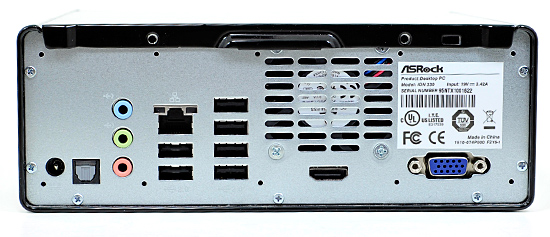
Inside there’s not much to see at first glance. Two screws hold the top cover on, removing them and sliding the cover back reveals the removable carrier that holds the slimline DVD drive and 2.5” HDD:
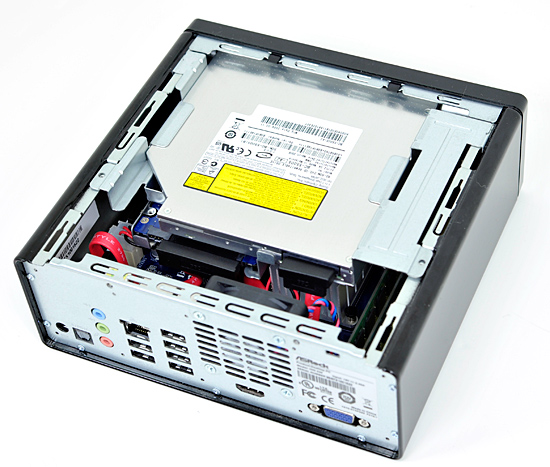
ASRock sent us the significantly more baller Ion 330-BD model, which forgoes the DVD drive for a slimline Blu-ray drive. The impact on price shouldn’t go unnoticed as the drive costs around $200 more than the standard DVD drive.
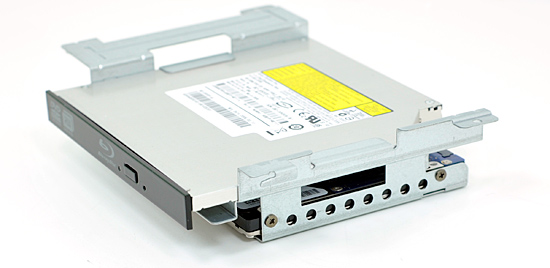
The slimline drive uses a mini-SATA power connector instead of standard SATA power. It’s supplied power somewhat crudely by a 4-pin 5V header on the motherboard that splits off and feeds both the optical drive and HDD.
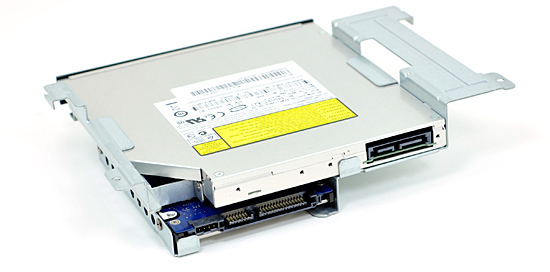
The hard drive is a standard 2.5” notebook drive. In this case it’s a 320GB Seagate Momentus 5400.6.
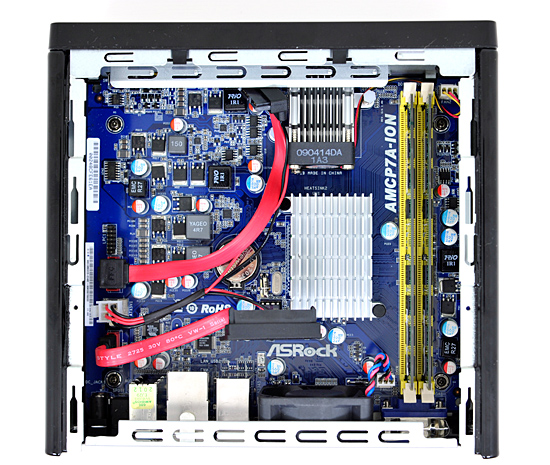
Below the drive carrier lies the motherboard itself and its two-fan cooling solution. A very small fan up front keeps the Atom processor cool. A larger fan in the back moves air around the rest of the chassis. The NVIDIA GPU doesn’t have a fan directly mounted to its heatsink and instead relies on the two fans to move heat off of its fins.
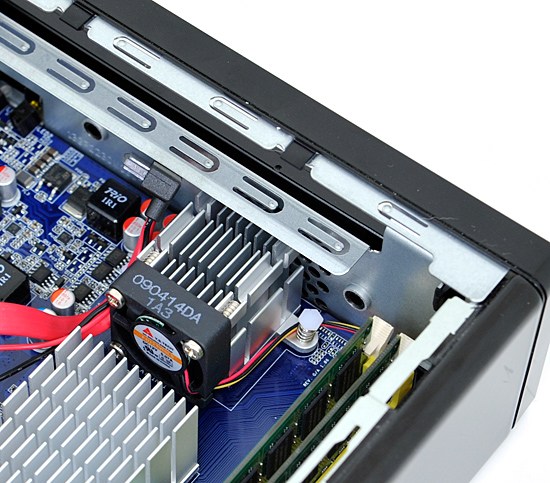
The smaller, and quieter CPU fan

The larger, and louder chassis fan
I hate to spoil the surprise, but the ASRock Ion 330 is built off of the same hardware as the ASUS and Zotac boards. You get a 1.6GHz dual-core Atom 330 combined with a NVIDIA GeForce 9300/9400M chipset. The result? Nearly identical performance.
The ASRock is nice from a convenience standpoint, all you do is buy the machine and load an OS on it. The major issues with it are a fan that isn’t silent (more on this later), and the fact that if you want to use an SSD in the machine you’re out $70 since it comes with a non-optional 2.5” HDD.










61 Comments
View All Comments
cghebert - Friday, August 28, 2009 - link
Anand,While SSDs obviously offer a speed increase, you can't store that many movies on them. And, if you have a small ITX case, there might not be room for two drives. Are the ION systems fast enough to play HD movies over ethernet, or would the two drives need to be in the same case?
Thanks for the review btw!
GeorgeH - Friday, August 28, 2009 - link
Right now you can get Zotac's LGA775 Mini-ITX GF9300 for 119 AR. Couple that with a $50 E1500, and you've got a $169 system that will destroy these ION platforms for the exact same price. Similar options exist on the AMD side as well (think GF8200 + X2 240 Regor for ~$160.)Given that those options exist, a comparison with Atom would be awesome, especially one covering noise, power consumption, and case choices - i.e. could you build an LGA775 Mini-ITX in a similar form factor as the ASRock with comparable acoustics, or do you really need the ultra-low power consumption and TDP of an Atom CPU?
eversteegt - Tuesday, November 3, 2009 - link
Great, but are you sure the GF 9300 on that board has the same core with the same features (like playing Full HD 1080p video completely hardware-accelerated in Linux) as the GF9300 core on the ION platform? ;)Pandamonium - Friday, August 28, 2009 - link
That Zotac board doesn't support wake on USB quite yet, as far as I can tell. That's a pretty huge deal breaker for HTPC duty.Personally, I want something only powerful enough to handle streaming HD. If Adobe/nVidia get their act together and offload Flash scaling to the GPU, the Atom gets my vote for the reduced TDP. For a system that will be sitting in an enclosed TV stand (glass door style), a low TDP is absolutely necessary.
GeorgeH - Saturday, August 29, 2009 - link
If the Zotac board doesn't work for you, you can pick up an Intel G45 board for ~$5-10 less. As to the TDP, the idle power of a 5050e/780G system can be as low as 35-40W, or about the same as the Asus ION board - which leads me to believe that they're also producing comparable amounts of heat at idle or when doing IGP accelerated video playback.Obviously the 5050e is going to be more efficient than the examples I listed (which I couldn't find reputable and relevant numbers for) and will consume much more power than the Atom under full CPU load, but that's not the point. The point is that I'm not quite convinced that ION is necessary or even the best option unless you're going with ultra-slim designs such as the Aspire Revo.
cghebert - Friday, August 28, 2009 - link
That's an excellent point. I actually just built a micro-ATX Athlon X2+Radeon 4550 based system as my HTPC because I wanted a system that could play Hulu and other streaming internet videos, something that the ION would limit.Plus, one beef I have about most ITX cases (at least that don't come with a DC adapter for their power supply) is that they are TALL. Taller than a nice micro-ATX case, which fits much better amongst my HT gear.
One case that I didn't look at that is worth mention for the ION is this one http://www.mini-box.com/M350-universal-mini-itx-en...">http://www.mini-box.com/M350-universal-mini-itx-en...
from the same people that make the PICO psu.
I'd also like to see a comparison between ION systems and low power ITX systems built with Intel or AMD desktop chips.
TA152H - Friday, August 28, 2009 - link
Intel did a nice job with the processor, but we're stuck with either getting the miserable 945, or buying something from a crap company (NVIDIA) that is at least somewhat modern.What a terrible choice. I'd love to own an Atom based file server, but what kind of choice is this? I'm not stupid enough to buy NVIDIA, but then, what kind of choice is the grotesquely obsolete 945 chipset?
It has taken Intel far too long to come out with a reasonable solution to this problem. You could overlook it for a few months, or even half a year, but it's gone on far too long. It's a pity ATI didn't enter this market. You'd have nice performance, and it wouldn't be so frightening to buy a product from them.
Anand, why put the Pentium 4 in the power tests? They kind of came out of nowhere, and, actually used less power than I thought they would. You really seem to have a weird fascination with the Netburst processors; probably because they were so bad, they are interesting. I will say this though, if they had been built on 45nm, with the much better power characteristics of this process, they'd probably hit 6 GHz in their sleep. Meaning, they'd perform roughly like the 2.0 GHz Core 2 :-P.
eversteegt - Tuesday, November 3, 2009 - link
Why this "steep" comment about NVIDIA being crap?For Linux users (like me), NVIDIA is the ONLY quality option to play back hardware-accelerated video. AMD does not even get close to build stable graphics drivers for Linux, let alone hardware-accelerated HD video. I think NVIDIA ION is the only platforum that gives the Atom a right to exist....
strikeback03 - Monday, August 31, 2009 - link
Intel does have a more modern chipset for Atom (the US15) but almost no one is using it. Whether this is due to cost or another stupid Intel limitation I do not know.bh192012 - Friday, August 28, 2009 - link
What was WOW like after you OC CPU and GPU? Also, if someone someday decided to actually cool these things with something bigger than a 40mm fan, can you hit 2.2 ghz etc.